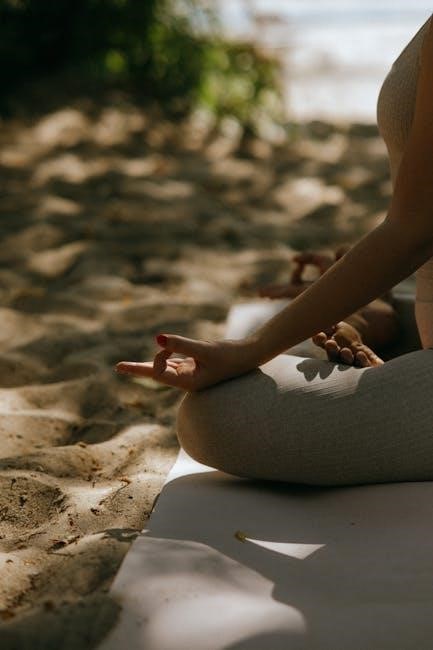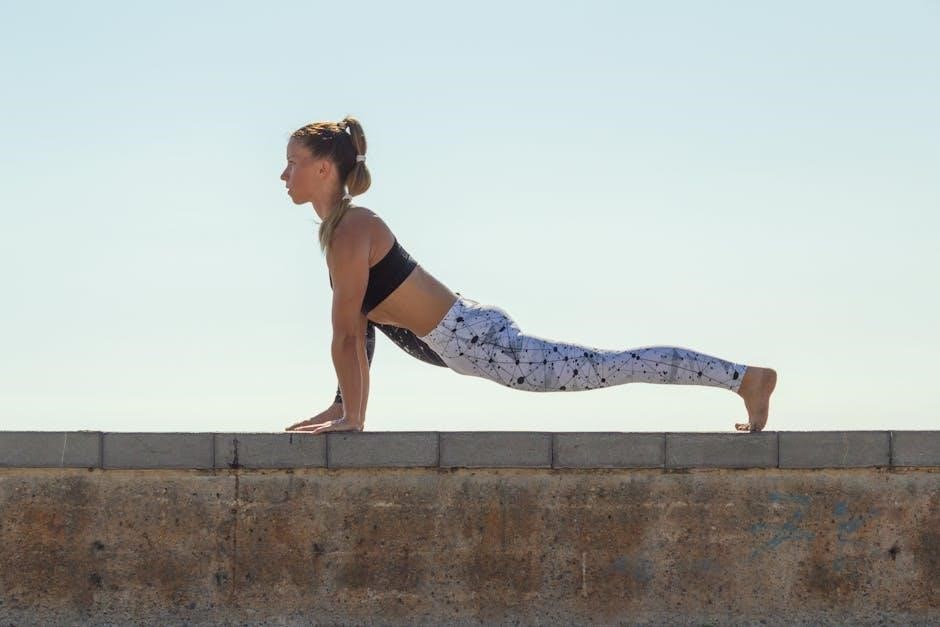Ashtanga yoga is a style of yoga developed by K. Pattabhi Jois, promoting classical Indian yoga, using methods and techniques, with a focus on physical postures and breathing exercises, for overall well-being and spiritual growth always.
Definition and Origin
Ashtanga yoga is a style of yoga that originated from the Yoga Sutras of Patanjali, an ancient Indian text that describes the eight limbs of yoga. The term Ashtanga refers to the eight limbs of yoga, which are the foundation of this style of yoga. According to the Internet, Ashtanga yoga was developed and popularized by K. Pattabhi Jois, who is often credited with promoting classical Indian yoga. The style of yoga is characterized by a set of physical postures, breathing exercises, and meditation techniques that are designed to promote physical, mental, and spiritual well-being. The origin of Ashtanga yoga can be traced back to the 1930s, when yoga master and Sanskrit scholar Sri Tirumalai Krishnamacharya discovered a mysterious manuscript written on a bundle of palm leaves, known as the Yoga Korunta. This manuscript is said to have contained the teachings of Ashtanga yoga, which were later developed and refined by K. Pattabhi Jois. Ashtanga yoga is now practiced by millions of people around the world, and is considered one of the most popular and influential styles of yoga. The definition of Ashtanga yoga is closely tied to its origins, and understanding its history and development is essential to appreciating its significance and importance.
History and Lineage

The history of Ashtanga yoga is deeply rooted in the teachings of Sri Tirumalai Krishnamacharya, a renowned yoga master and Sanskrit scholar. According to historical accounts, Krishnamacharya discovered a mysterious manuscript known as the Yoga Korunta, which contained the teachings of Ashtanga yoga. This manuscript is said to have been written on a bundle of palm leaves and was discovered in the 1930s. Krishnamacharya’s disciple, K. Pattabhi Jois, played a significant role in developing and popularizing Ashtanga yoga. Jois went on to establish the Ashtanga Yoga Research Institute, where he taught and refined the practice of Ashtanga yoga. The lineage of Ashtanga yoga is characterized by a direct transmission of knowledge from teacher to student, with each generation building upon the teachings of the previous one. This lineage has been preserved and continued by Jois’s daughter, Saraswati, and his grandson, Sharath, who remain prominent figures in the Ashtanga yoga community. The history and lineage of Ashtanga yoga are a testament to the enduring power and significance of this ancient practice. The tradition of Ashtanga yoga continues to evolve and grow, with a global community of practitioners and teachers.

Philosophy and Practice
Ashtanga yoga combines physical postures, breathing techniques, and mental focus, using
traditional
methods for spiritual growth and self-realization always naturally.
Eight Limbs of Yoga
The eight limbs of yoga are the foundation of Ashtanga yoga, providing a holistic approach to yoga practice, and are described in the Yoga Sutras of Patanjali.
The eight limbs are yamas, niyamas, asanas, pranayama, pratyahara, dharana, dhyana, and samadhi, which are interconnected and interdependent, and are used to achieve a state of spiritual growth and self-realization.
The yamas and niyamas provide a moral and ethical framework for yoga practice, while the asanas and pranayama provide a physical and energetic foundation.
The pratyahara, dharana, dhyana, and samadhi limbs provide a framework for meditation and spiritual growth, and are used to achieve a state of inner peace and liberation.
The eight limbs of yoga are a comprehensive and integrated system, and are used in Ashtanga yoga to provide a complete and holistic approach to yoga practice.
By following the eight limbs of yoga, practitioners can achieve a deeper understanding of themselves and the world around them, and can experience a sense of spiritual growth and self-realization.
The eight limbs of yoga are a key component of Ashtanga yoga, and are used to provide a framework for yoga practice that is both physically and spiritually challenging.
Primary Series and Vinyasa Count
The Primary Series is a set of yoga postures in Ashtanga yoga, designed to build internal heat, strength, and flexibility, and is typically practiced in a specific order, with a focus on vinyasa, or breath-synchronized movement.
The vinyasa count is a system of counting the breaths and movements in Ashtanga yoga, used to create a meditative and flowing practice, and is an essential component of the Primary Series.
The Primary Series is composed of approximately 75 postures, including standing postures, seated postures, and backbends, and is designed to be a challenging and transformative practice.
The vinyasa count is used to link the postures together, creating a continuous flow of movement and breath, and is an important aspect of the Ashtanga yoga tradition.
By practicing the Primary Series with a focus on vinyasa count, students can develop a deeper understanding of the Ashtanga yoga method, and can experience the many benefits of this traditional and holistic practice.
The Primary Series and vinyasa count are fundamental components of Ashtanga yoga, and are used to create a practice that is both physically and spiritually challenging, and deeply rewarding.

Resources and Manuals
Ashtanga yoga manuals and resources are available online, including
downloadable
PDF guides and practice sheets, providing valuable information and support for students and teachers alike always and everywhere together freely.
Asana Practice Sheets
Ashtanga yoga asana practice sheets are valuable resources for students and teachers, providing a comprehensive guide to the various postures and sequences. These sheets, often available in PDF format, can be downloaded and printed for easy reference. They typically include detailed descriptions and illustrations of each asana, as well as tips for proper alignment and breathing techniques. Many practice sheets also include space for notes and reflections, allowing practitioners to track their progress and identify areas for improvement. Some popular sources for asana practice sheets include the official Ashtanga Yoga website and online forums, where experienced teachers and practitioners share their knowledge and expertise. By using these practice sheets, students can deepen their understanding of the asana practice and develop a more consistent and meaningful home practice. The use of asana practice sheets can also help to foster a sense of community and connection among practitioners, as they share and learn from one another. Overall, asana practice sheets are a useful tool for anyone looking to explore and deepen their practice of Ashtanga yoga. They offer a wealth of information and guidance, and can be a valuable companion on the journey of yoga practice.
The Practice Manual
The practice manual is a comprehensive guide to Ashtanga yoga, designed to provide students with a clear and concise understanding of the practice. It typically includes a detailed overview of the primary series, as well as guidelines for developing a personal practice. The manual may also include information on the history and philosophy of Ashtanga yoga, as well as tips for cultivating a consistent and meaningful practice. Many practice manuals are available in PDF format, making it easy to access and download the information. Some manuals may also include photographs or illustrations to help demonstrate the various postures and sequences. The practice manual is an essential resource for anyone looking to deepen their understanding of Ashtanga yoga and develop a strong foundation for their practice. By following the guidelines and principles outlined in the manual, students can cultivate a consistent and meaningful practice that brings them greater physical, mental, and emotional well-being. The manual is a valuable tool for both beginners and experienced practitioners, offering a wealth of information and guidance to support their practice. It is a useful companion for anyone looking to explore the depths of Ashtanga yoga.

and Further Study
Ashtanga yoga students can continue learning through online resources, workshops, and
classes
to deepen their practice and understanding always and everywhere with ease and comfort using pdf guides.
Continuing Education
Ashtanga yoga practitioners can continue their education through various means, including online courses, workshops, and classes, which provide opportunities to deepen their practice and understanding of the tradition. Many schools and institutes offer teacher training programs, allowing students to become certified instructors and share their knowledge with others. Additionally, there are numerous online resources, such as videos, podcasts, and blogs, that offer guidance and support for practitioners of all levels. Some organizations also provide continuing education credits for yoga teachers, which can help them stay up-to-date with the latest developments and research in the field. By pursuing continuing education, Ashtanga yoga practitioners can refine their skills, expand their knowledge, and cultivate a more nuanced and informed approach to their practice. This can lead to a more profound and rewarding experience, as well as a greater sense of community and connection with like-minded individuals. Overall, continuing education is an essential aspect of the Ashtanga yoga tradition, as it allows practitioners to grow and evolve in their practice.
Authentic Sources
For those seeking authentic sources on Ashtanga yoga, there are several reputable options available. The official website of the Krishna Pattabhi Jois Ashtanga Yoga Institute is a valuable resource, offering insights into the tradition and its history. Additionally, the works of K. Pattabhi Jois and his grandson, Sharath Jois, provide a wealth of information on the practice and philosophy of Ashtanga yoga. Other authentic sources include the writings of Gregor Maehle, who has written extensively on the subject, and the teachings of the late Sri K. Pattabhi Jois, which have been preserved and made available through various media. It is essential to consult these authentic sources to gain a deeper understanding of the tradition and to separate fact from fiction. By doing so, practitioners can ensure that their practice is rooted in the authentic teachings of Ashtanga yoga, rather than being influenced by misconceptions or inaccuracies. This approach will allow them to cultivate a more nuanced and informed practice, one that is grounded in the tradition’s rich history and philosophy. Authentic sources are essential for a genuine practice.
